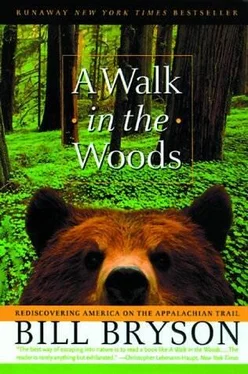Bill Bryson - A Walk In The Woods
Здесь есть возможность читать онлайн «Bill Bryson - A Walk In The Woods» весь текст электронной книги совершенно бесплатно (целиком полную версию без сокращений). В некоторых случаях можно слушать аудио, скачать через торрент в формате fb2 и присутствует краткое содержание. Жанр: Современная проза, на английском языке. Описание произведения, (предисловие) а так же отзывы посетителей доступны на портале библиотеки ЛибКат.
- Название:A Walk In The Woods
- Автор:
- Жанр:
- Год:неизвестен
- ISBN:нет данных
- Рейтинг книги:4 / 5. Голосов: 1
-
Избранное:Добавить в избранное
- Отзывы:
-
Ваша оценка:
- 80
- 1
- 2
- 3
- 4
- 5
A Walk In The Woods: краткое содержание, описание и аннотация
Предлагаем к чтению аннотацию, описание, краткое содержание или предисловие (зависит от того, что написал сам автор книги «A Walk In The Woods»). Если вы не нашли необходимую информацию о книге — напишите в комментариях, мы постараемся отыскать её.
A Walk In The Woods — читать онлайн бесплатно полную книгу (весь текст) целиком
Ниже представлен текст книги, разбитый по страницам. Система сохранения места последней прочитанной страницы, позволяет с удобством читать онлайн бесплатно книгу «A Walk In The Woods», без необходимости каждый раз заново искать на чём Вы остановились. Поставьте закладку, и сможете в любой момент перейти на страницу, на которой закончили чтение.
Интервал:
Закладка:
We had found the Smokies.
Far below, squeezed into a narrow valley, was Fontana Lake, a long, fjordlike arm of pale green water. At the lake’s western end, where the Little Tennessee River flows into it, stands a big hydroelectric dam, 480 feet high, built by the Tennessee Valley Authority in the 1930s. It is the biggest dam in America east of the Mississippi and something of an attraction for people who like concrete in volume. We hastened down the trail to it as we had an inkling that there was a visitors’ center there, which meant the possibility of a cafeteria and other gratifying contacts with the developed world. At the very least, we speculated excitedly, there would be vending machines and rest rooms, where we could wash and get fresh water, look in a mirror-briefly be groomed and civilized.
There was indeed a visitors’ center, but it was shut. A peeling notice taped to the glass said it wouldn’t open for another month. The vending machines were empty and unplugged, and to our dismay even the rest rooms were locked Katz found a tap on an outside wall and turned it, but the water had been shut off. We sighed, exchanged stoic, long-suffering looks, and pushed on.
The trail crossed the lake on the top of the dam. The mountains before us didn’t so much rise from the lake as rear from it, like startled beasts. It was clear at a glance that we were entering a new realm of magnificence and challenge. The far shore of the lake marked the southern boundary of Great Smoky Mountains National Park. Ahead lay 800 square miles of dense, steeply mountainous forest, with seven days and 71 miles of rigorous hiking before, we came out the other end and could dream again of cheeseburgers, Cokes, flush toilets, and running water. It would have been nice, at the very least, to have set off with clean hands and faces. I hadn’t told Katz, but we were about to traverse sixteen peaks above 6,000 feet, including Clingmans Dome, the highest point on the AT at 6,643 feet (just 41 feet less than nearby Mount Mitchell, the highest mountain in the eastern United States). I was eager and excited-even Katz seemed cautiously keen-for there was a good deal to be excited about.
For one thing, we had just picked up another state-our third, Tennessee-which always brings a sense of achievement on the trail. For nearly its whole length through the Smokies, the AT marks the boundary between North Carolina and Tennessee. I liked this very much, the idea of being able to stand with my left foot in one state and my right foot in the other whenever I wanted, which was often, or to choose at rest breaks between sitting on a log in Tennessee and a rock in North Carolina, or to pee across state lines, or many other variations. Then there was the excitement of all the new things we might see in these rich, dark, storied mountains-giant salamanders and towering tulip trees and the famous jack-o-lantern mushroom, which glows at night with a greenish phosphorescent light called foxfire. Perhaps we would even see a bear (downwind, from a safe distance, oblivious of me, interested exclusively in Katz, if either of us). Above all, there was the hop-the conviction-that spring could not be far off, that every passing day had to bring us closer to it, and that here in the natural Eden of the Smokies it would surely, at last, burst forth.
For the smokies are a very Eden. We were entering what botanists like to call “the finest mixed mesophytic forest in the world.” The Smokies harbor an astonishing range of plant life-over 1,500 types of wildflower, a thousand varieties of shrub, 530 mosses and lichen, 2,000 types of fungi. They are home to 130 native species of tree; the whole of Europe has just 85.
They owe this lavish abundance to the deep, loamy soils of their sheltered valleys, known locally as coves; to their warm, moist climate (which produces the natural bluish haze from which they get their name); and above all to the happy accident of the Appalachians’ north-south orientation. During the last ice age, as glaciers and ice sheets spread down from the Arctic, northern flora all over the world naturally tried to escape southwards. In Europe, untold numbers of native species were crushed against the impassable barrier of the Alps and its smaller cousins and fell into extinction. In eastern North America, there was no such impediment to retreat, so trees and other plants found their way through river valleys and along the flanks of mountains until they arrived at a congenial refuge in the Smokies, and there they have remained ever since. (When at last the ice sheets drew back, the native northern trees began the long process of returning to their former territories. Some, like the white cedar and rhododendron, are only now reaching home-a reminder that, geologically speaking, the ice sheets have only just gone.)
Rich plant life naturally brings rich animal life. The Smokies are home to sixty-seven varieties of mammal, over 200 types of bird, and eighty species of reptile and amphibian’all larger numbers than are found in comparable-sized areas almost anywhere else in the temperate world. Above all, the Smokies are famous for their bears. The number of bears in the park is not large-estimates range from 400 to 600-but they are a chronic problem because so many of them have lost their fear of humans. More than nine million people a year come to the Smokies, many of them to picnic. So bears have learned to associate people with food. Indeed, to them people are overweight creatures in baseball caps who spread lots and lots of food out on picnic tables and then shriek a little and waddle off to get their video cameras when old Mr. Bear comes along and climbs onto the table and starts devouring their potato salad and chocolate cake. Since the bear doesn’t mind being filmed and indeed seems indifferent to his audience, pretty generally some fool will come up to it and try to stroke it or feed it a cupcake or something. There is one recorded instance of a woman smearing honey on her toddler’s fingers so that the bear would lick it off for the video camera. Failing to understand this, the bear ate the baby’s hand.
When this sort of thing happens (and about a dozen people a year are injured, usually at picnic sites, usually by doing something dumb) or when a bear becomes persistent or aggressive, park rangers shoot it with a tranquilizer dart, truss it up, take it into the depths of the backcountry, far from roads and picnic sites, and let it loose. Of course by now the bear has become thoroughly habituated both to human beings and to their food. And who will they find to take food from out in the back country? Why, from me and Katz, of course, and others like us. The annals of Appalachian Trail hikes are full of tales of hikers being mugged by bears in the back country of the Smokies. And so as we plunged into the steep, dense, covering woods of Shuckstack Mountain, I stayed closer than usual to Katz and carried my walking stick like a club. He thought I was a fool, of course.
The true creature of the Smokies, however, is the reclusive and little-appreciated salamander. There are twenty-five varieties of salamander in the Smokies, more than anywhere else on earth. Salamanders are interesting, and don’t let anyone tell you otherwise. To begin with, they are the oldest of all land vertebrates. When creatures first crawled from the seas, this is what came up, and they haven’t changed a great deal since. Some varieties of Smokies salamander haven’t even evolved lungs. (They breathe through their skin.) Most salamanders are tiny, only an inch or two long, but the rare and startlingly ugly hellbender salamander can attain lengths of over two feet. I ached to see a hellbender.
Even more varied and underappreciated than the salamander is the freshwater mussel. Three hundred types of mussel, a third of the world’s total, live in the Smokies. Smokies mussels have terrific names, like purple wartyback, shiny pigtoe, and monkeyface pearlymussel. Unfortunately, that is where all interest in them ends. Because they are so little regarded, even by naturalists, mussels have vanished at an exceptional rate. Nearly half of all Smokies mussels species are endangered; twelve are thought to be extinct.
Читать дальшеИнтервал:
Закладка:
Похожие книги на «A Walk In The Woods»
Представляем Вашему вниманию похожие книги на «A Walk In The Woods» списком для выбора. Мы отобрали схожую по названию и смыслу литературу в надежде предоставить читателям больше вариантов отыскать новые, интересные, ещё непрочитанные произведения.
Обсуждение, отзывы о книге «A Walk In The Woods» и просто собственные мнения читателей. Оставьте ваши комментарии, напишите, что Вы думаете о произведении, его смысле или главных героях. Укажите что конкретно понравилось, а что нет, и почему Вы так считаете.












